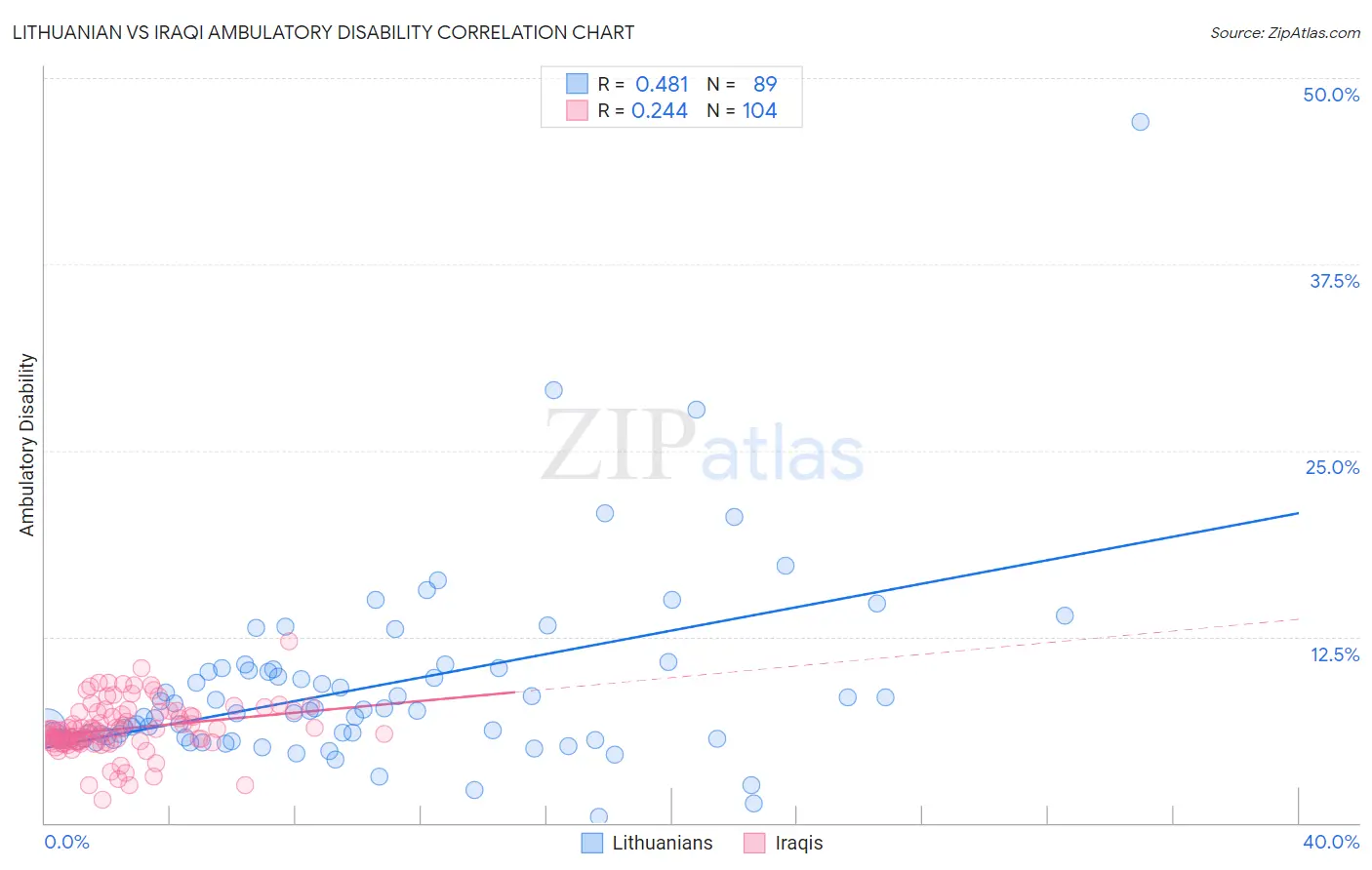Lithuanian vs Iraqi Ambulatory Disability
COMPARE
Lithuanian
Iraqi
Ambulatory Disability
Ambulatory Disability Comparison
Lithuanians
Iraqis
6.0%
AMBULATORY DISABILITY
81.9/ 100
METRIC RATING
149th/ 347
METRIC RANK
6.1%
AMBULATORY DISABILITY
62.8/ 100
METRIC RATING
166th/ 347
METRIC RANK
Lithuanian vs Iraqi Ambulatory Disability Correlation Chart
The statistical analysis conducted on geographies consisting of 421,829,236 people shows a moderate positive correlation between the proportion of Lithuanians and percentage of population with ambulatory disability in the United States with a correlation coefficient (R) of 0.481 and weighted average of 6.0%. Similarly, the statistical analysis conducted on geographies consisting of 170,645,130 people shows a weak positive correlation between the proportion of Iraqis and percentage of population with ambulatory disability in the United States with a correlation coefficient (R) of 0.244 and weighted average of 6.1%, a difference of 1.3%.

Ambulatory Disability Correlation Summary
| Measurement | Lithuanian | Iraqi |
| Minimum | 0.40% | 1.6% |
| Maximum | 47.1% | 12.2% |
| Range | 46.7% | 10.7% |
| Mean | 9.0% | 6.3% |
| Median | 7.4% | 6.2% |
| Interquartile 25% (IQ1) | 5.7% | 5.4% |
| Interquartile 75% (IQ3) | 10.3% | 7.4% |
| Interquartile Range (IQR) | 4.6% | 2.0% |
| Standard Deviation (Sample) | 6.3% | 1.7% |
| Standard Deviation (Population) | 6.3% | 1.7% |
Demographics Similar to Lithuanians and Iraqis by Ambulatory Disability
In terms of ambulatory disability, the demographic groups most similar to Lithuanians are Immigrants from Eastern Europe (6.0%, a difference of 0.010%), Maltese (6.0%, a difference of 0.020%), Immigrants from Moldova (6.0%, a difference of 0.050%), Greek (6.0%, a difference of 0.20%), and Immigrants from Austria (6.0%, a difference of 0.27%). Similarly, the demographic groups most similar to Iraqis are Nicaraguan (6.1%, a difference of 0.020%), Basque (6.1%, a difference of 0.050%), Immigrants from Oceania (6.1%, a difference of 0.12%), Lebanese (6.1%, a difference of 0.20%), and Nigerian (6.1%, a difference of 0.25%).
| Demographics | Rating | Rank | Ambulatory Disability |
| Immigrants | Moldova | 82.4 /100 | #147 | Excellent 6.0% |
| Immigrants | Eastern Europe | 82.0 /100 | #148 | Excellent 6.0% |
| Lithuanians | 81.9 /100 | #149 | Excellent 6.0% |
| Maltese | 81.6 /100 | #150 | Excellent 6.0% |
| Greeks | 79.6 /100 | #151 | Good 6.0% |
| Immigrants | Austria | 78.8 /100 | #152 | Good 6.0% |
| Syrians | 75.5 /100 | #153 | Good 6.0% |
| Immigrants | Croatia | 75.1 /100 | #154 | Good 6.0% |
| Immigrants | Scotland | 72.1 /100 | #155 | Good 6.0% |
| Northern Europeans | 71.8 /100 | #156 | Good 6.0% |
| Ghanaians | 71.3 /100 | #157 | Good 6.0% |
| Immigrants | Fiji | 71.2 /100 | #158 | Good 6.0% |
| Immigrants | Latvia | 71.1 /100 | #159 | Good 6.0% |
| Central Americans | 69.8 /100 | #160 | Good 6.0% |
| Immigrants | Belarus | 69.2 /100 | #161 | Good 6.1% |
| Nigerians | 67.1 /100 | #162 | Good 6.1% |
| Lebanese | 66.2 /100 | #163 | Good 6.1% |
| Basques | 63.7 /100 | #164 | Good 6.1% |
| Nicaraguans | 63.2 /100 | #165 | Good 6.1% |
| Iraqis | 62.8 /100 | #166 | Good 6.1% |
| Immigrants | Oceania | 60.7 /100 | #167 | Good 6.1% |